Bún Bò Huế Recipe – Spicy Vietnamese Beef & Pork Noodle Soup
Bún bò Huế is a hidden Vietnamese gem that has yet to “make it” in mainstream American cuisine. It’s a rich and spicy soup with deep layers of flavor. This Central Vietnamese soup is paired with tender slices of beef and pork, then topped with lots of fresh herbs.
I consulted my favorite Vietnamese cook–Mom–on how to make bún bò Huế. And to find out subleties that make BBH authentic. I promise you’ll love this version!
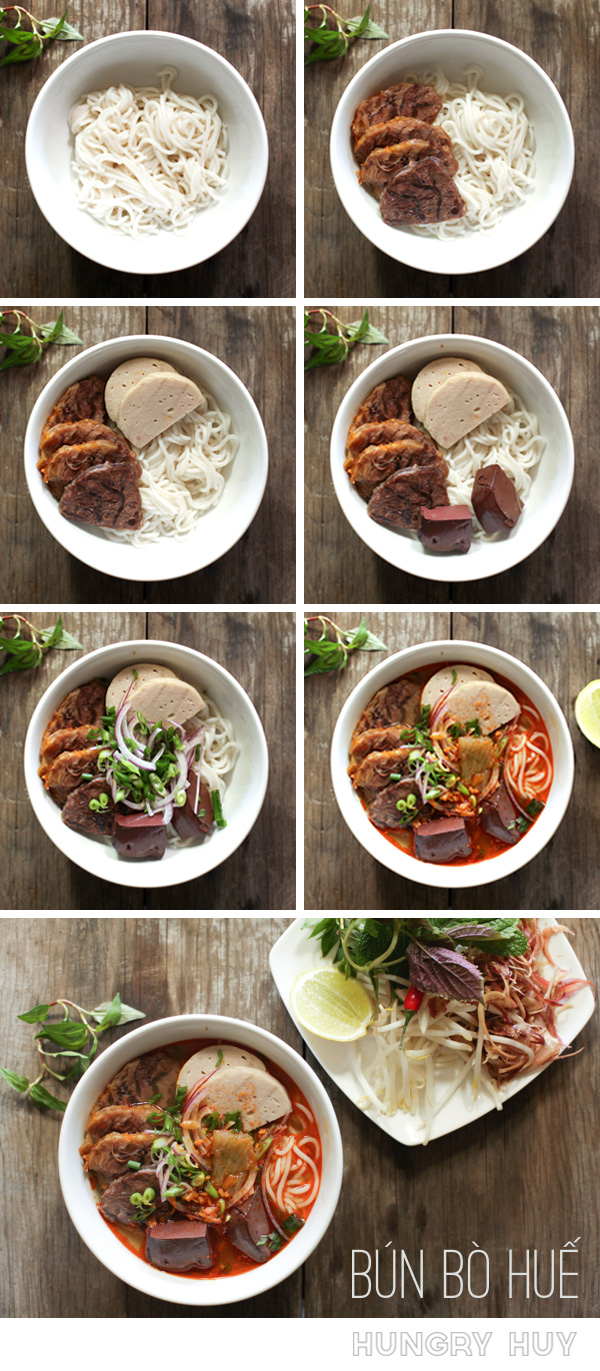
Mục Lục
Not as popular as phở….yet?
Phở has claimed some serious territory here and has grown popular quickly. According to data from Google, since 2004 compared to March 2021, phở has grown in popularity by 830%, which is an amazing gain.
Comparatively, for the previous 12 months starting March 2021, bún bò Huế is much less popular at a measly 1.2% of the searches for phở. But why isn’t phở’s equally spicy and attractive cousin allowed to join the party?
It has a lot of familiar and identifiable ingredients–a good step in getting people to eat something new. BBH has a few curveballs that could be holding it back from quicker adoption: shrimp paste and pork blood.
America seems to not be ready for this as a mainstay yet, whereas pho’s concept is easily recognizable and pitched as beef or chicken noodle soup. BUT bún bò Huế is not something you should look over–definitely give it a shot and you may love it even more than phở!
Bún bò Huế history
The city of Huế was put on the map as Vietnam’s capital in 1802 when the Nguyen Dynasty seized control of the country and ruled from this central city.
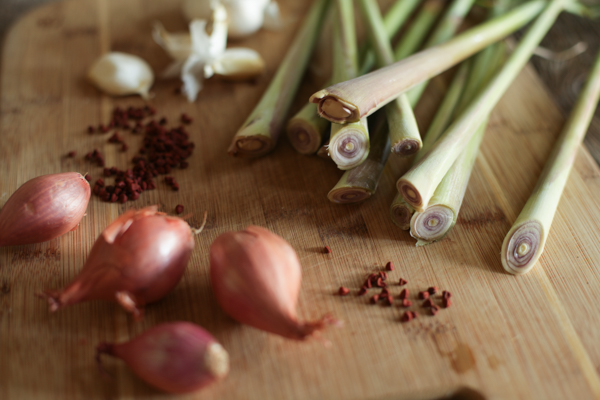
This city has a reputation for having spicy foods–not something as common with other Vietnamese cuisine. My mom believes there’s no real reason for it other than trying to boost flavor when there weren’t other options. Sounds kinda like what you hot sauce fiends out there do yeah?
Huế also just happens to be the origin of many of my favorite dishes. This city is responsible for bánh nậm, bánh bột lọc, cơm hến (omg), and of course bún bò Huế. Lez get cookin!
There will be blood (congealed and cubed)
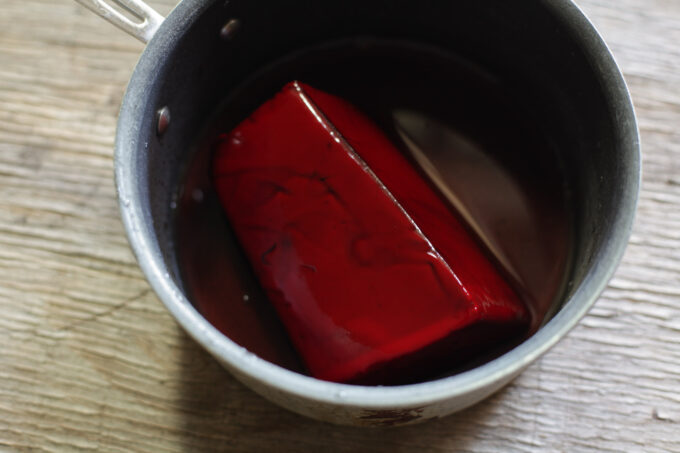
An authentic component of BBH is cubes of congealed pork blood. You coagulate it by sitting fresh blood in a container, then boiling with salt to solidify it. It’s kinda dense, slightly chewy and holds its shape when bitten.
On a recent episode of Parts Unknown, Anthony Bourdain dishes on what he needs in a romantic partner: “I would definitely bring a date for [bun bo hue]. Because if she doesn’t like this, there’s no hope of a relationship. If she said, ‘Oh, I don’t know, there’s blood and stuff in there,’ that would be a relationship-ender to me. I’m not kidding.”
If making BBH just for myself, I’d forfeit my chances with Bourdain and skip the pork blood. Shh!
The banana flowers
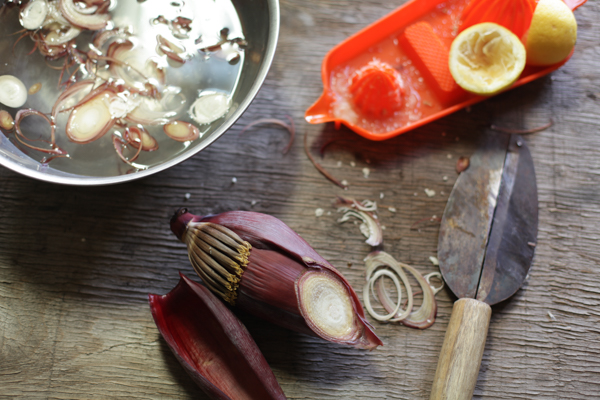
Another interesting & traditional ingredient in this soup is sliced banana flower (or banana blossoms).
You can find these in Vietnamese, Chinese, Thai and other Asian markets. I even found this at a local Persian market! This is a neat addition to this dish but is by no means required. If you can’t find banana flower, move on. You can still make some amazing BBH without it.
Prepare your bowl of lemon water, then remove all the petals. Discard all the little fronds (the mini banana-like fellas). The lemon keeps the petals from browning and removes some of its bitter taste.
Unless it’s a Huế-specific restaurant, shops don’t bother serving this because it’s pricey and troublesome to prepare. If you don’t have access to these blossoms, you can do as the restaurants do and use red cabbage as a stand-in.
The saté / spicy chile condiment
BBH is a spicy soup, so surprise there’s a chile condiment / paste that goes with this pot of soup! And it’s incredibly easy to make, it just has a lot of ingredients.
You literally just rehydrate the dried chiles, mince the fresh aromatics, then throw everything into a pan on medium and stir until it thickens up and intensifies.
It takes a long time but it’s worth it! You can make more than the amount I list in the recipe card below, to store in the fridge for future BBH parties or to give away.
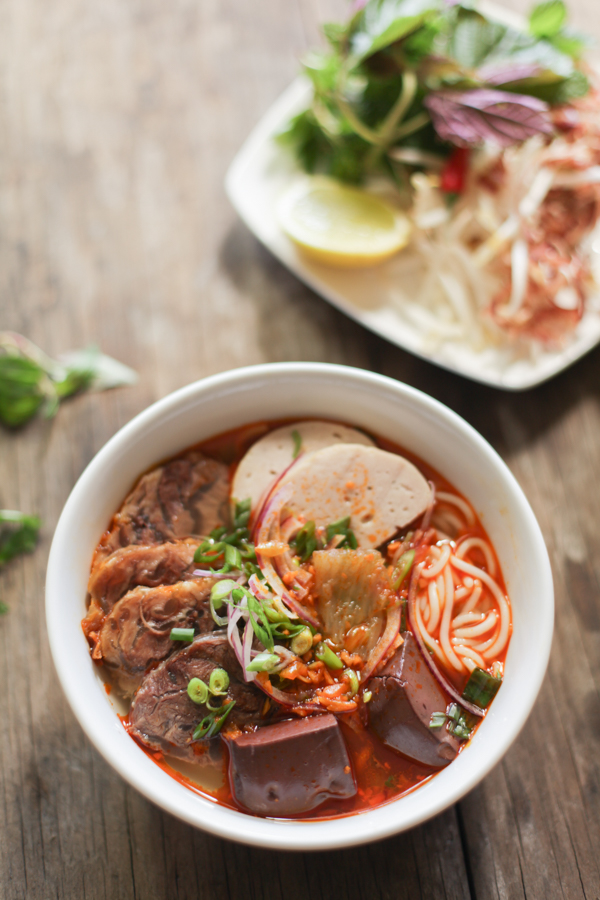
To answer some commonly asked questions…
Whats the difference between bún bò Huế and phở?
So many things! Lets start with the noodles: phở is actually named after the flat noodles in this soup, while bún bò Huế uses round noodles.
The broth in phở is typically all beef, or all chicken, and served with cuts of meat from the same animal, while bún bò Huế typically uses both beef and pork in the same broth. Bún bò Huế broth packs more of a punch with the use of shrimp paste, pork bones, and chile paste.
Phở is not lacking in flavor by any means, as it can be incredibly rich and satisfying in its own way.
Is bún bò Huế Spicy?
Yes, traditionally, and typically. However, the bún bò Huế broth base we make below, I like to make it not spicy at all. In my family and friend groups there’s always a spectrum of spicyness people can handle.
If you leave the broth at 0 spice, and leave the spicy chile paste on the side, each person can make it as spicy as they like.
Does bún bò Huế have pork?
Yes. It’s kinda funny “bún bò Huế” means Huế beef noodle soup, but it can have just as much or even more pork than it does beef.
In our recipe below, we use pork hocks, Huế style pork sausage, and congealed pork blood. Vegetarians beware.
What does bún bò Huế mean?
“Bún bò Huế” literally translates to Huế beef noodle soup.
Where does bún bò Huế come from?
Huế is a city in central Vietnam from where this noodle soup originates.
How do you eat bún bò Huế?
With chopsticks and soup spoon! But really, prepare a bowl with the soup and broth, add as little or as much meat as you’d like, then top it off with the veggies listed below: mint, Thai basil, bean sprouts, and banana flower.
The veggies make it a smidge healthier, and helps cool down the soup too.
The final touch will be how much spicy chile paste you add to the soup, and a spritz of lime if you prefer.
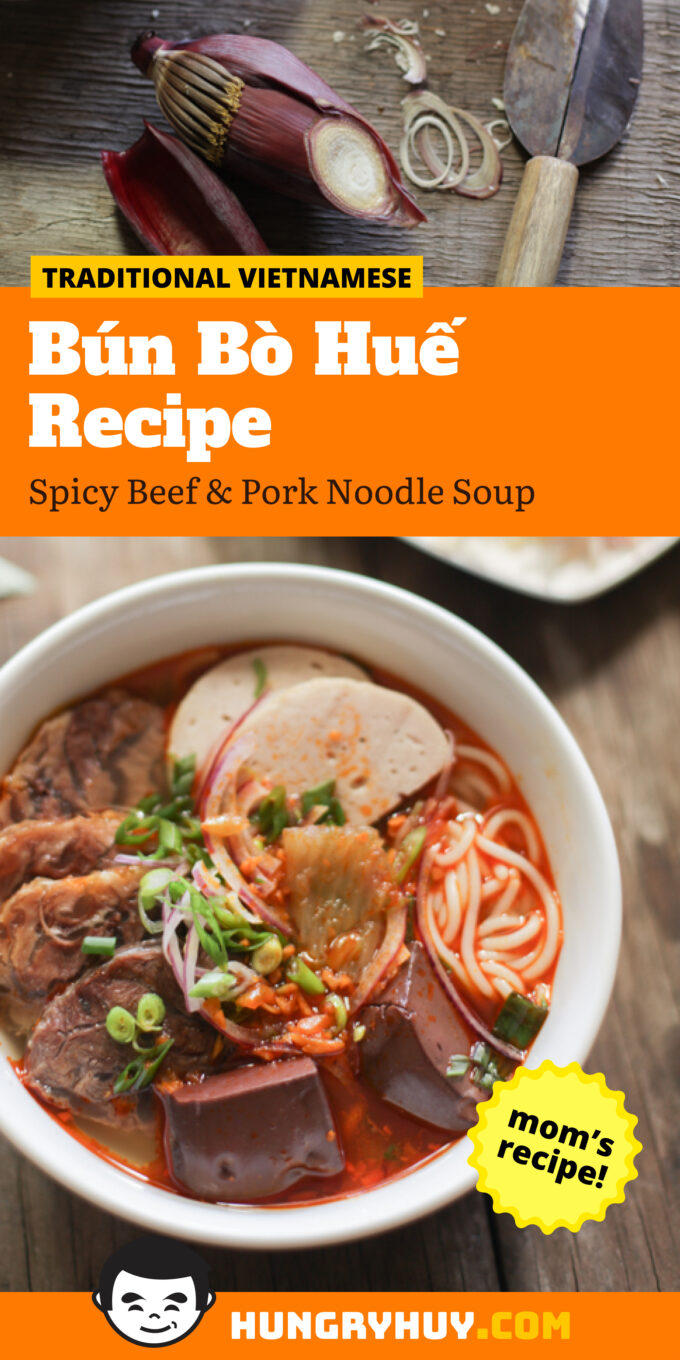
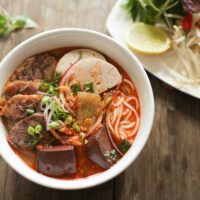
Bún Bò Huế – Spicy Vietnamese Beef & Pork Noodle Soup
from
votes
A rich and flavorful Vietnamese soup that is absoultely loaded with aromatics, pork flavor and meat with a refreshing contrast of crisp and light veggies and a spritz of lemon.
PIN
Prep:
30
mins
Cook:
3
hrs
Total:
3
hrs
30
mins
SERVINGS:
8
bowls
Ingredients
-
▢
2
lb
(
907.2
g
)
beef shank
-
▢
2
lb
(
907.2
g
)
oxtail
-
▢
2
lb
(
907.2
g
)
pork hocks
-
▢
1
lb
(
453.6
g
)
Huế style pork sausage
chả Huế, which has garlic and whole peppercorns
-
▢
1
lb
(
453.6
g
)
block of pork blood
Broth base & Seasoning
-
▢
water
I used an 8 quart pot, and added water to cover the meat.
-
▢
24
oz
chicken broth
-
▢
12
stalks
lemongrass
leafy tops removed, roots smashed
-
▢
2
yellow onions, large
halved, to be removed from the broth after fully cooked.
-
▢
3
tbsp
salt
-
▢
2
tbsp
sugar
-
▢
2
tbsp
shrimp paste
Lee Kum Kee brand
-
▢
3-4
tbsp
fish sauce
-
▢
2
tsp
MSG (monosodium glutamate)
if not using oxtail, add 4 teaspoons
Aromatics & Color
-
▢
3
tbsp
anatto seeds
-
▢
3
tbsp
neutral cooking oil
-
▢
2
tbsp
shallot
sliced
-
▢
2
tbsp
garlic
minced
Herbs & Veg
-
▢
mint
-
▢
basil
-
▢
bean sprouts
-
▢
birds eye chile or jalapeno
-
▢
lime
sliced
Banana Flower
-
▢
1
banana flower
-
▢
2
cups
water
-
▢
1
lemon
juiced
Noodles
-
▢
14
oz
(
396.9
g
)
package dried rice noodle
medium or large thickness
Saté (spicy chile condiment)
-
▢
20
g
dried Thai chile
crushed
-
▢
1/2
c
neutral cooking oil
-
▢
80
g
shallot or white onion
minced
-
▢
40
g
garlic
minced
-
▢
30
g
lemongrass
minced
-
▢
2
tbsp
Korean chile powder (gochugaru)
-
▢
1
tbsp
fish sauce
-
▢
1
tbsp
sugar
-
▢
2/3
tsp
salt
-
▢
1/2
tsp
MSG (monosodium glutamate)
Instructions
Broth
-
Clean the meat: Add all meat to a stock pot and enough water to submerge it, bring to a boil. Drain and rinse thoroughly under running water.
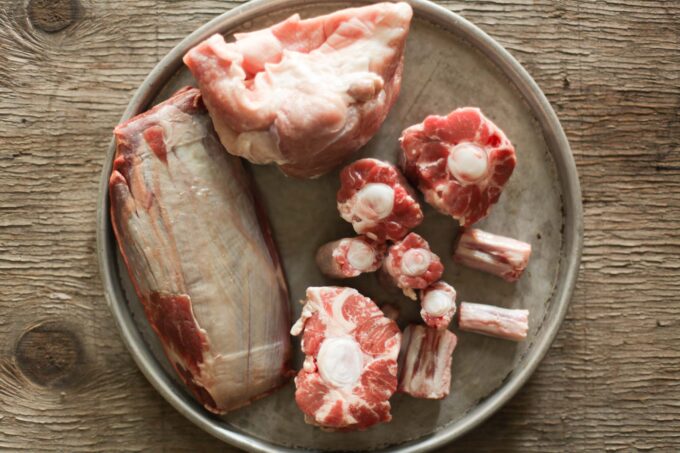
-
Add the meat, broth, lemongrass and onions to the pot and fill with water almost to the brim. Bring to a boil then drop the heat to medium-high to maintain a low boil. Add the seasoning.
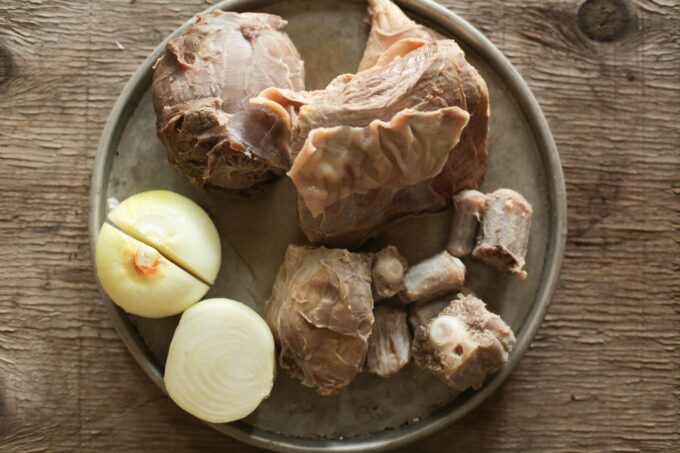
-
Let it simmer and periodically check the meats for doneness and remove them as they finish cooking. The pork should be done after about an hour, the beef can vary between 2-3 hours.
-
After all the meat has removed, let it cool, then slice it. Adjust seasoning and add water to the broth pot if necessary.
-
Make the aromatics & coloring then add it to the pot.
-
Boil noodles according to package instructions.
-
Assemble your bowl, and serve with herbs and veg on a side platter.
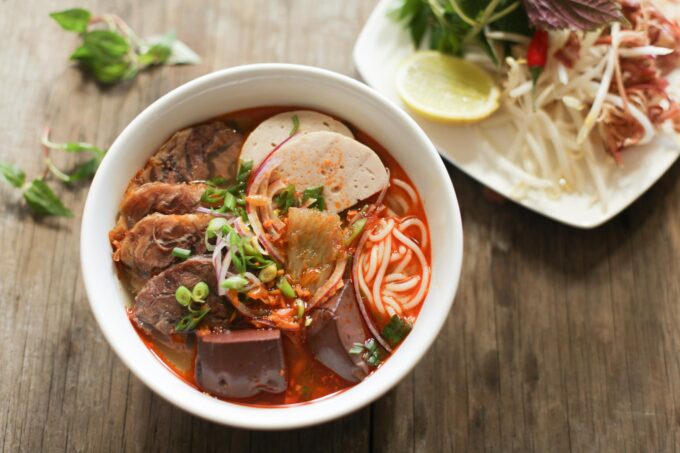
Red Coloring & Aromatics
-
Sauté seeds in oil on medium heat until the seeds give up the bright red color, then remove the seeds.
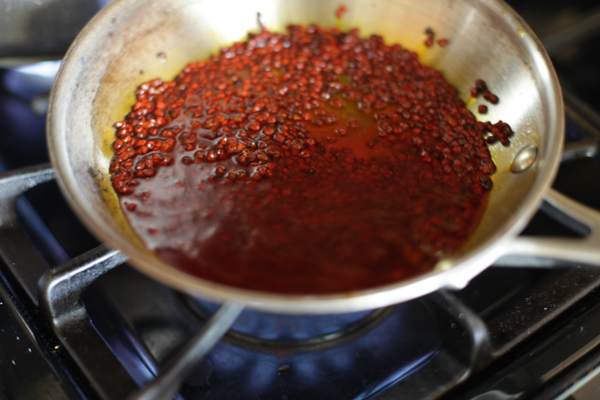
-
Add shallots and garlic, sauté until brown.
-
Add all of this to the pot of broth for color.
Pork Blood (Huyet / Tiet)
-
The easiest thing to do is just buy it already cooked and boil just to heat it up. If you use the raw type like we did for this recipe, cut into 1″ cubes and boil for 30-45 minutes

Banana Flower
-
Prepare a bowl of about 2 cups of water, mixed with the juice of 1 lemon.
-
Thinly slice the banana flower and add to the water mixture to sit for about 30 minutes.

-
Avoid adding little fronds (that look like mini bananas), removing them as you encounter them. They taste bitter!
Saté (spicy chile condiment)
-
Weigh out the dried Thai chiles, then soak in just enough warm water to cover the chiles for 20 minutes. Drain the water.
-
Add all sate ingredients to a pan on medium heat and stir continuously to brown, cook, and slightly reduce the chile paste, about 30-40 minutes. If at any point it becomes too dry, you can add more oil, up to 50% of the amount we started with. Taste and reseason with sugar or salt as desired. See photo for how the final product should look.
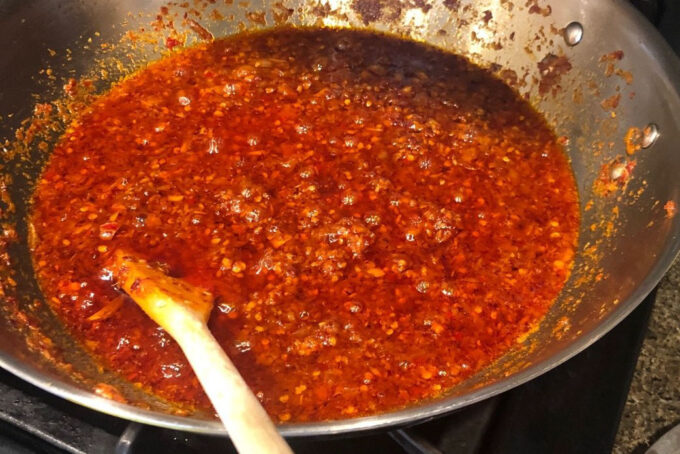
-
Let cool and transfer to a sealed jar stored in the fridge . You can add ~2 tbsp of the final product to the soup pot for a boost in flavor and color, or simply and let each person add to their bowl to make it as spicy as they’d like!
Notes
2/11/2021: Added recipe for sate (spicy chile condiment)
Calories note: The actual calories per bowl may be lower by 200-250kcal than listed, since the saté / chile condiment typically isn’t fully used up for a single pot of this soup.
Nutrition Facts
Serving:
0
g
|
Calories:
1276.7
kcal
|
Carbohydrates:
61.37
g
|
Protein:
89.95
g
|
Fat:
73.1
g
|
Saturated Fat:
20.9
g
|
Trans Fat:
0.2
g
|
Cholesterol:
330.02
mg
|
Sodium:
4939.39
mg
|
Potassium:
1181.93
mg
|
Fiber:
2.55
g
|
Sugar:
7.32
g
|
Vitamin A:
671.03
IU
|
Vitamin C:
18.37
mg
|
Calcium:
143.14
mg
|
Iron:
11.91
mg
Did you cook this recipe?
Tag @HungryHuy or #hungryhuy –I’d love to see it!
Like this recipe? Subscribe to my newsletter!
![]()















![Toni Kroos là ai? [ sự thật về tiểu sử đầy đủ Toni Kroos ]](https://evbn.org/wp-content/uploads/New-Project-6635-1671934592.jpg)


